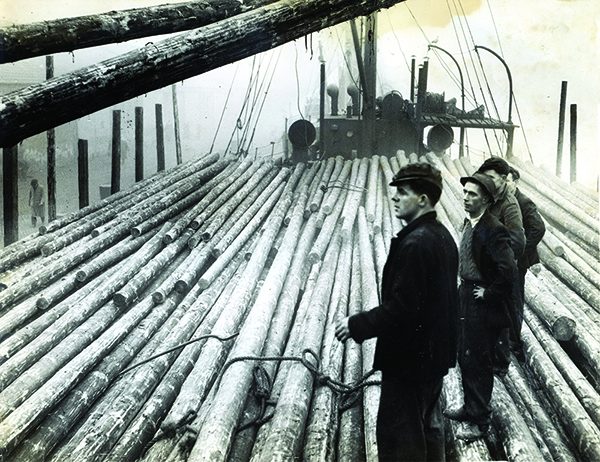
The Dock Read Foremen allocate work to the men who gather and wait to hear their name called. Image courtesy of Dublin Dockworkers Preservation Society
As part of the Five Lamps Arts Festival this year, a group of former dockworkers from the Dublin Dockworkers Preservation Society (DDPS) got together with playwright Niamh Gleeson to stage a series of performances in which they recounted their working days.
The initiative was sponsored by the unions as part of Mayfest 2017. The performances were recorded by the Connolly Media Group and are available to view on the DDPS website.
In one of the videos, The Struggle to Find Work, Paddy Daly, who worked as a docker and later as a foreman, tells of the practice known as The Reads, the system used to allocate work before “de-casualisation” was introduced.
During the 1940’s and 1950’s a docker worker’s life was a hard life. In all, about 3,000 men depended on Dublin Port for their income. The majority of them came from dockland communities such as Ringsend and Pearse Street, East and North Wall and the North Inner City.
Work was allocated on a daily basis by the foremen at The Reads. The men would gather in front of four to six raised platforms on the quayside waiting for their name to be called and their duties assigned if they were lucky. Dockworkers followed The Reads day in day out and in all sorts of weather. There were no shelters and none of the conveniences that we take for granted in today’s workplace. Nevertheless, the system was a more acceptable way of allocating labour than the dangerous practice of hobbling, where rowing crews competed to reach an incoming ship or trade vessel first as they made their way into Dublin Bay. The crew that got a line on board first would get the job of guiding the vessel into the port, and could assign the unloading and loading and any ancillary work that went with it.
The Reads system was not as random as it appears. Things were more or less organised the night before, usually in the pubs where the dockworkers would gather to collect their pay. It was common for the work crews to be paid by the foremen in the pubs around the docks when the working day was done. This had predictable results and many of their families suffered poverty as a result.
In addition to the insecure nature of the work, the dockers had to tolerate low level corrupt practices such as ‘matchboxing’, handing the foreman a box of matches to light his cigarette with ‘something’ in it if they wanted to stay in favour and get the work. Such practices were commonplace. Nepotism and favouritism played a part too. The all-powerful foremen could assign the work to whoever they wanted, so naturally family members and their friends were chosen first.
It was an imperfect system. As Paddy explains, “It wasn’t just that was wrong. It was the graft attached to that and the whole system that was wrong. It was degrading.”
But at the end of the day it was the foremen who ran the place. They decided how many gangs were needed to do the work and they could choose who would be placed in the gangs.
At the start of WWII the shipping companies and cargo owners decided that it was no longer feasible to leave the work of handling their valuable assets – the ships and cargos – to casual labour, especially with ships being lost to the water at an alarming rate. Calls for changed working practices came mainly from the English side. It was decided that order should be introduced and that regular guys should be offered the work.
In 1947-48 a Register of dockworkers was introduced, designed to satisfy the needs of not only the ship and cargo owners but the demands of the insurance companies too.
The men were now required to register if they wanted to get work. They had to be recognised by the unions and approved by the foremen first. Registered men were issued with a button badge which helped the foremen quickly and easily identify the registered “buttonmen” even if they didn’t know them personally. The reason the dockworkers had to comply with the button system was because the shipping companies and the unions together, agreed to implement it. The foremen were obliged to pick the men with the identifying buttons over the men who didn’t have them. They were to be allocated work first.
In theory this should have improved things but in practice the foremen found ways to subvert the system and continued to allocate the most lucrative work to family members and friends, often over the registered men. One common practice was to assign work to men who had a fondness for drink on the evening before the job started, knowing that they were unlikely to turn up, especially at weekends. They could then be replaced with men of the foremen’s own choosing.
After WWII the shipping companies continued to introduce more regular work practices and to eliminate the casual nature of the job. One improvement was to introduce weekly rather than daily payments. The cross-channel section was the first to introduce regular working practices and a weekly wage.
The authorities at the port made every effort to enforce the changes. The new system was introduced to the cross-channel work first. It didn’t happen until 1946 for the deep sea workers because the ever-powerful foremen resisted the changes which meant that they had to choose button men over their own, whether they wanted to or not.
Former docker Declan Byrne told NewsFour: “Companies came and went, and like the bankers today they could make massive profits. They didn’t keep records. It was always a dangerous working environment; that was a constant. The unions and the companies looked for ways to regularise the system but only about 50% of the dockers supported the changes. The other 50% still saw it as an exploitative system. You had to follow the work for years and to join a union to get the button. The problem was when men got too old to work or died their button could be passed on, usually to a son. There was a cap on the number of buttons issued. So you could get 16 year olds getting work ahead of men who had been following The Read for years.”
Today, the traditional dockworker has been displaced by containerisation and roll on- roll-off facilities. Work on the docks is now highly specialised and working conditions at Dublin Port have improved immeasurably.
by Jennifer Reddin



